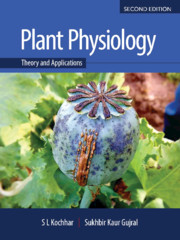Book contents
- Frontmatter
- Contents
- Foreword
- Preface to the Second Edition
- Preface to the First Edition
- Acknowledgements
- Some Common Abbreviations used in the Text
- Abbreviations for Units
- Unit I Water and Mineral Translocation in Plants
- Unit II Metabolism and Bioenergetics
- Unit III Growth and Development
- Unit IV Physiological Stress and Secondary Metabolites – Their Role in Metabolism
- Unit V Crop Physiology – An Innovative Approach
- Unit VI Breakthroughs in Plant Physiology
- Unit VII Some Experimental Exercises
- Glossary
- References
- Index
- Colour Plates
Chapter 11 - Lipid Metabolism
Published online by Cambridge University Press: 12 May 2020
- Frontmatter
- Contents
- Foreword
- Preface to the Second Edition
- Preface to the First Edition
- Acknowledgements
- Some Common Abbreviations used in the Text
- Abbreviations for Units
- Unit I Water and Mineral Translocation in Plants
- Unit II Metabolism and Bioenergetics
- Unit III Growth and Development
- Unit IV Physiological Stress and Secondary Metabolites – Their Role in Metabolism
- Unit V Crop Physiology – An Innovative Approach
- Unit VI Breakthroughs in Plant Physiology
- Unit VII Some Experimental Exercises
- Glossary
- References
- Index
- Colour Plates
Summary
Lipids constitute a heterogenous category of cellular components with low water solubility, but higher miscibility in organic solvents like acetone, benzene, chloroform and ether. Lipids play four primary roles in living organisms:
1. They are a constituent of certain structural framework of cells, particularly membranebound organelles (for example, glycerophospholipids and sphingolipids).
2. They may be stored within the cells as reserve sources of energy (for example, triacylglycerols).
3. Fatty acids derivatives function as hormones (i.e., prostaglandins) and intracellular second messengers, e.g., diacylglycerol (DAG) and inositol-1,4,5-triphosphate ( IP3 ).
4. Several proteins are covalently linked by the fatty acids. For example, myristic (C14) and palmitic acid (C16) are directly attached to some proteins.
Like carbohydrates, lipids (fats) consist of only carbon, hydrogen and oxygen but in a varied proportion, with relatively very little oxygen. Lipids can be conveniently grouped into various categories – triglycerides, phospholipids, sphingolipids, glycolipids, steroids, terpenes and waxes.
Naturally occurring lipids are normally a mixture of triglycerides of different fatty acids that are generally configured as shown below:
R1, R2 and R3 denote the carbon chains of various fatty acids.
Fatty Acids: Structure and Properties
A fatty acid comprises of a hydrocarbon chain with a terminal carboxyl group. Generally the fatty acids present in a biological system possess an even number of carbon atoms organized in an unbranched chain. Normally the chain length varies from 14 to 24 carbon atoms, with the most commonly occurring fatty acids consisting of 16–18 carbon atoms.
The fatty acids have been grouped into two categories – saturated and unsaturated. Saturated fatty acid contains all the carbon atoms present in its chain saturated with hydrogen atoms, with the general formula CH3(CH2)nCOOH, where n is an even number. Monounsaturated fatty acids (MUFA) possess only one double bond in their structure, while polyunsaturated fatty acids (PUFA) contain two or more double bonds, all with cis configuration. However, during the oxidation of fatty acids, some trans–isomers are produced.
- Type
- Chapter
- Information
- Plant PhysiologyTheory and Applications, pp. 352 - 373Publisher: Cambridge University PressPrint publication year: 2020



